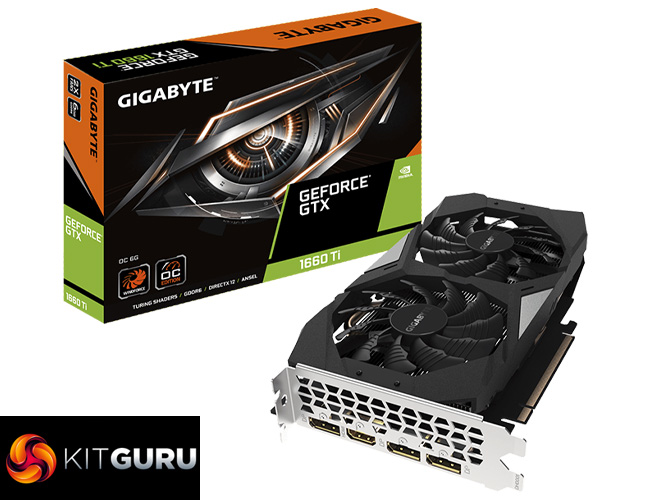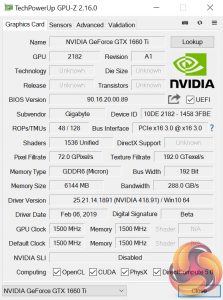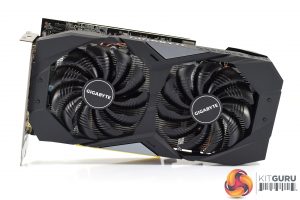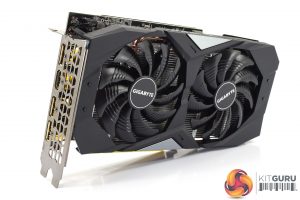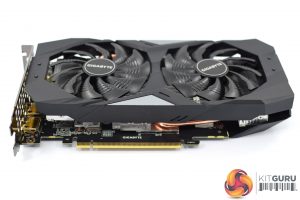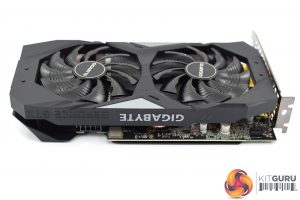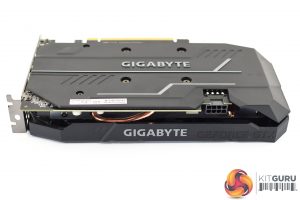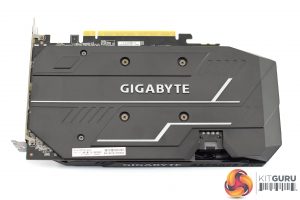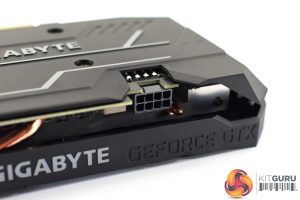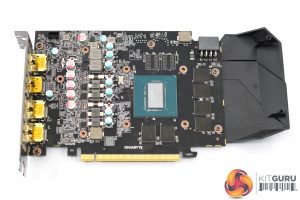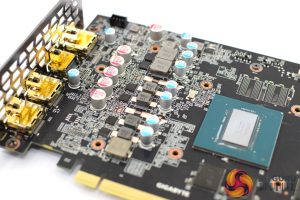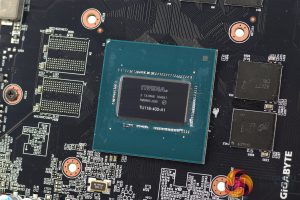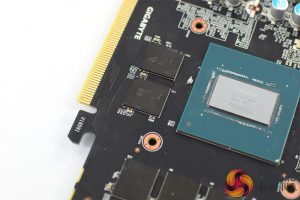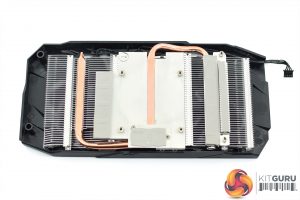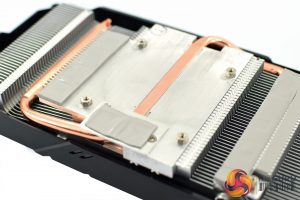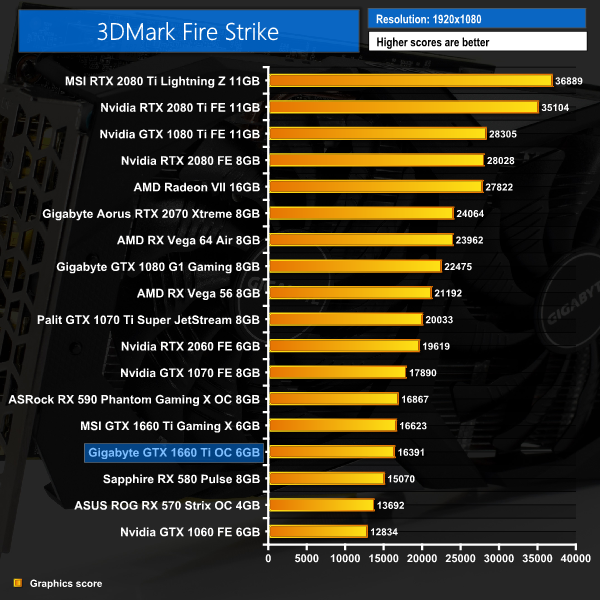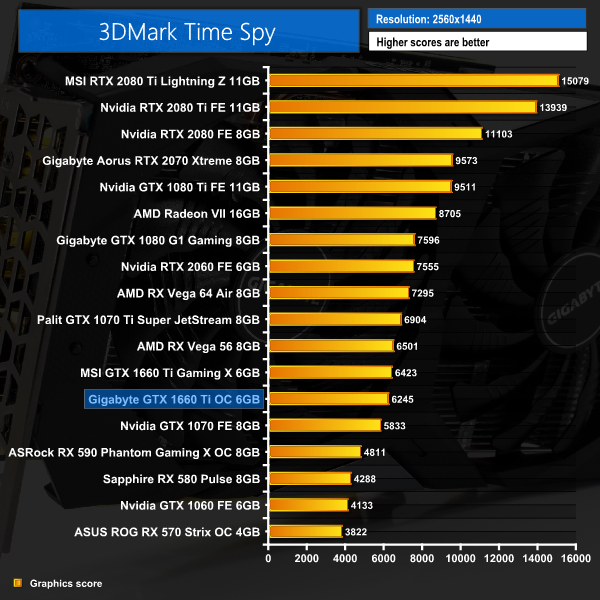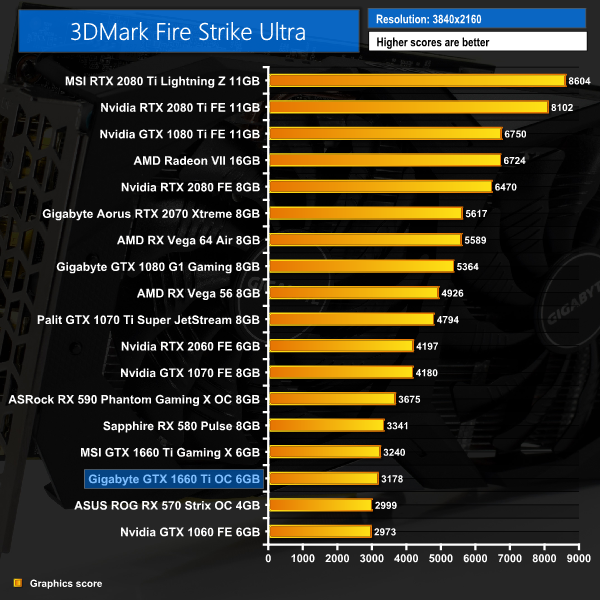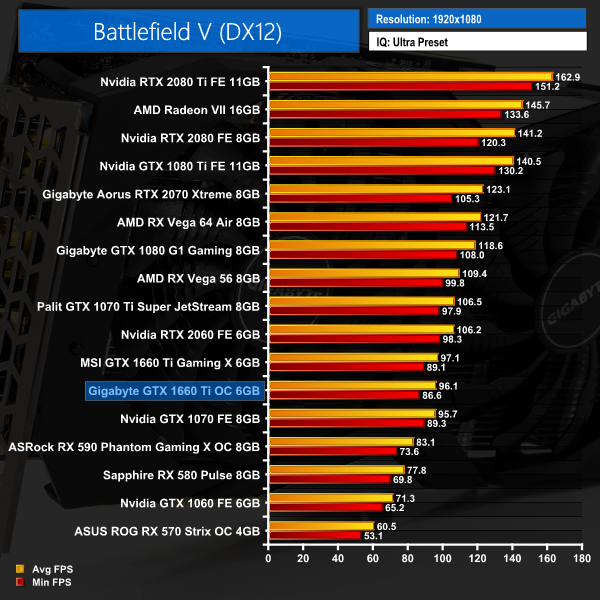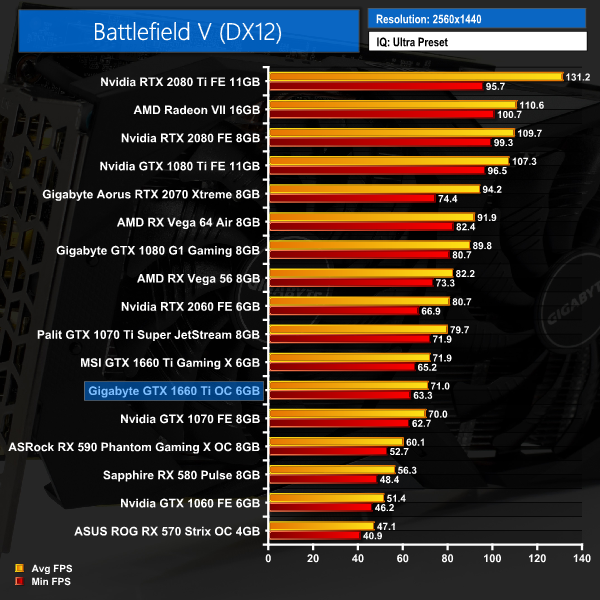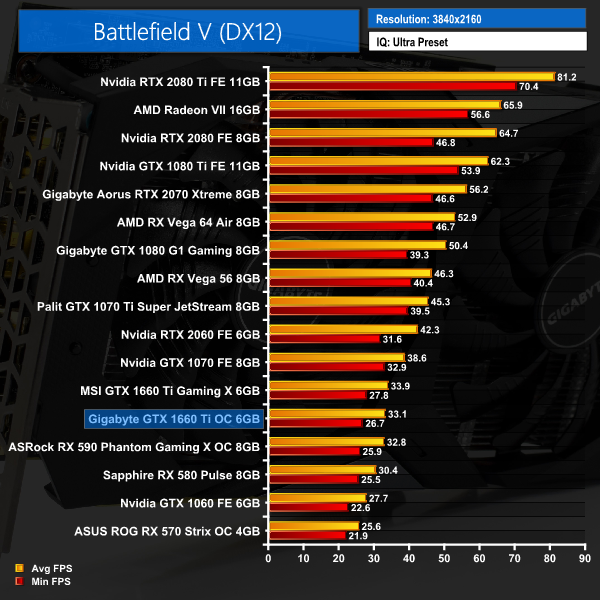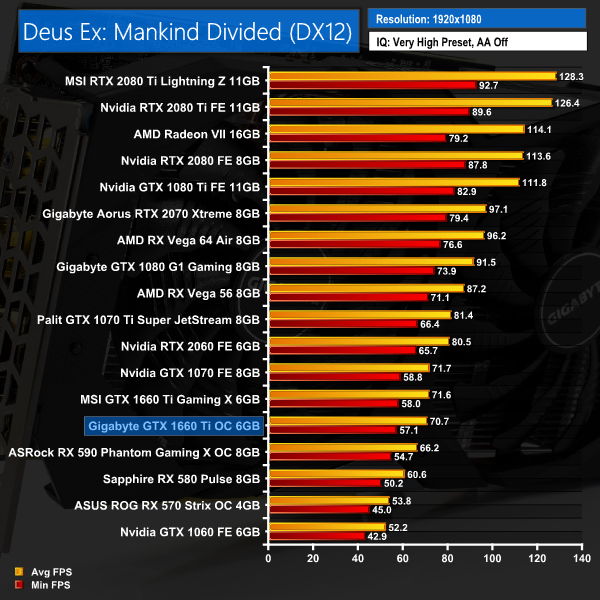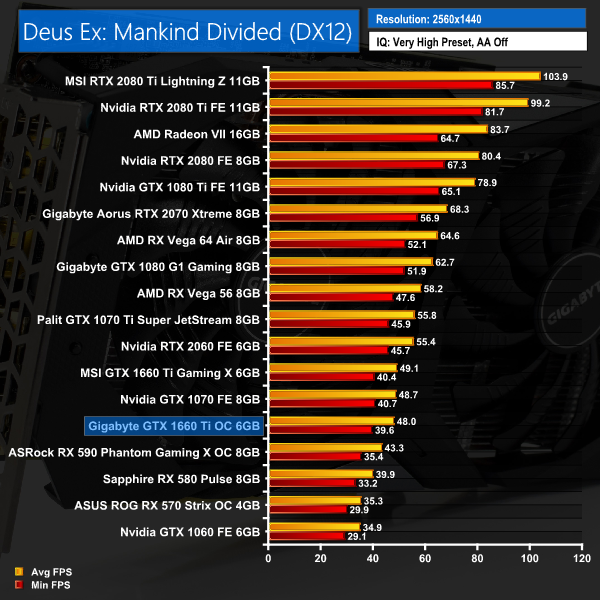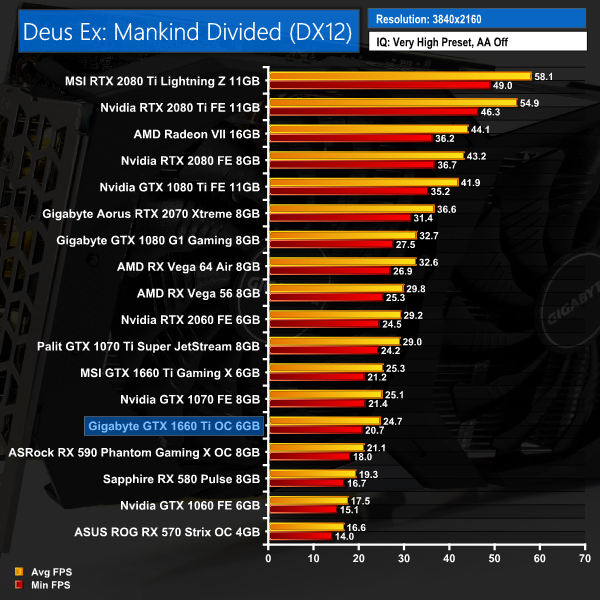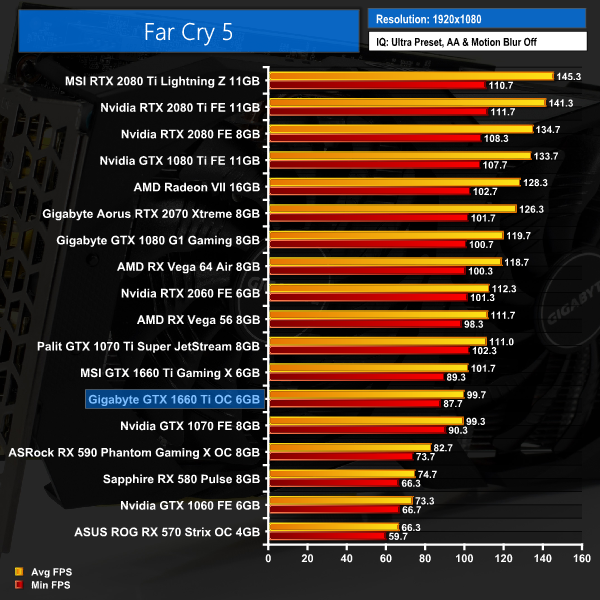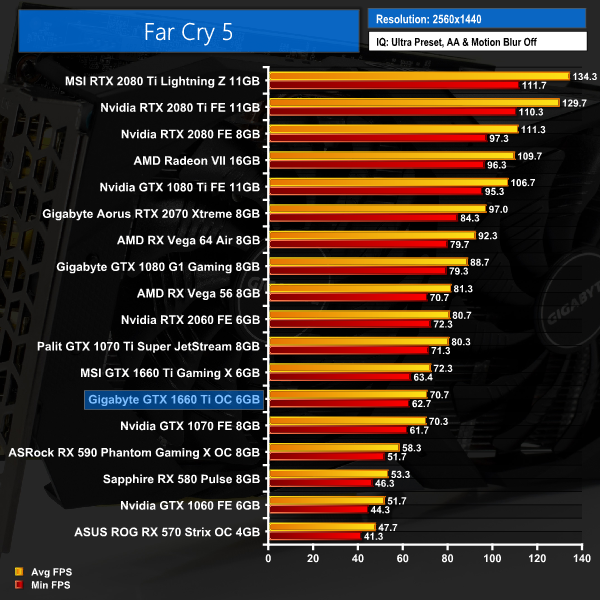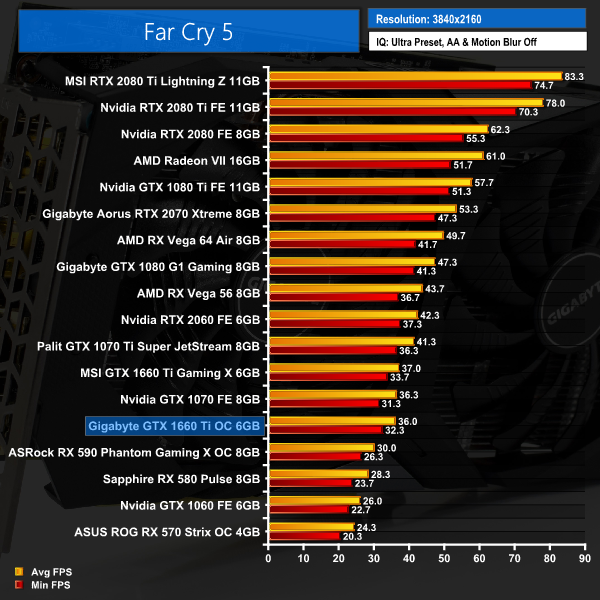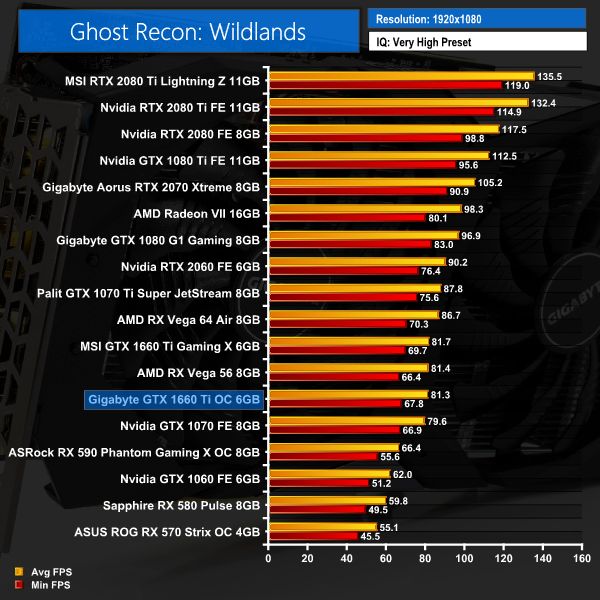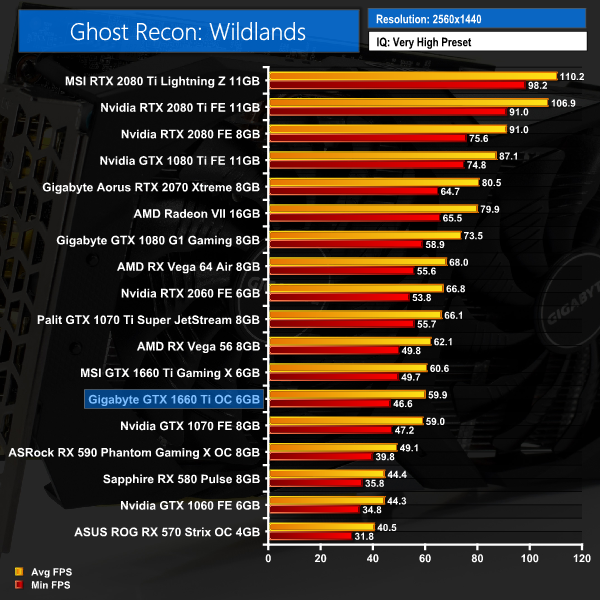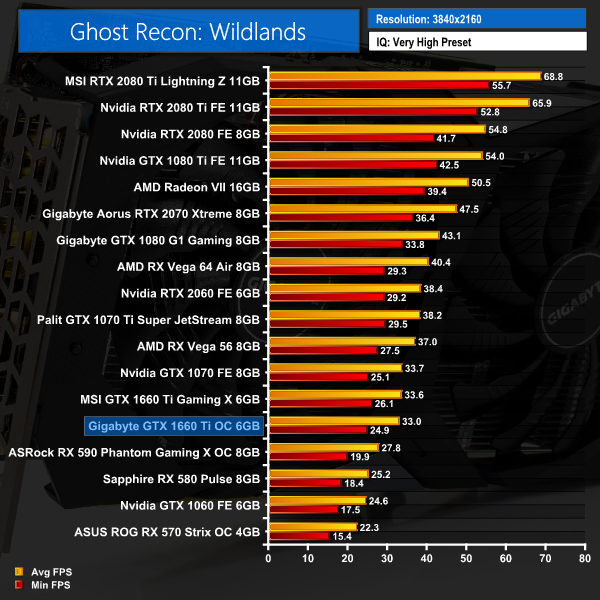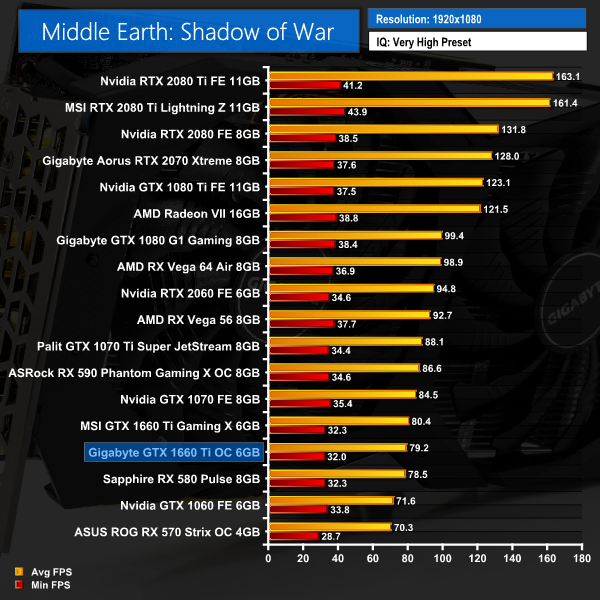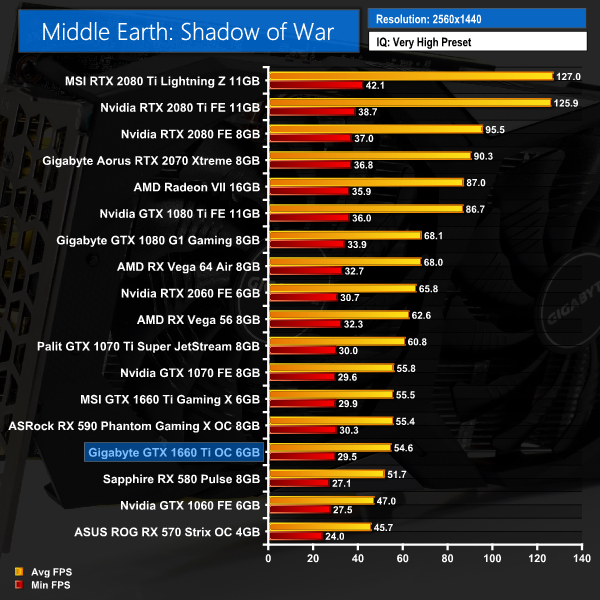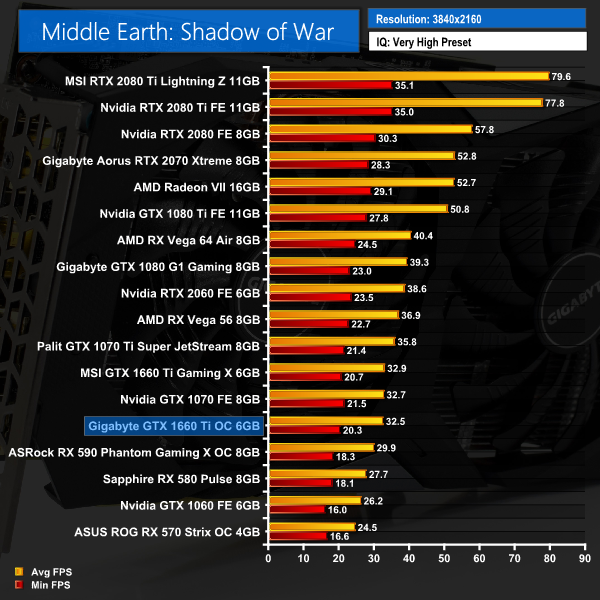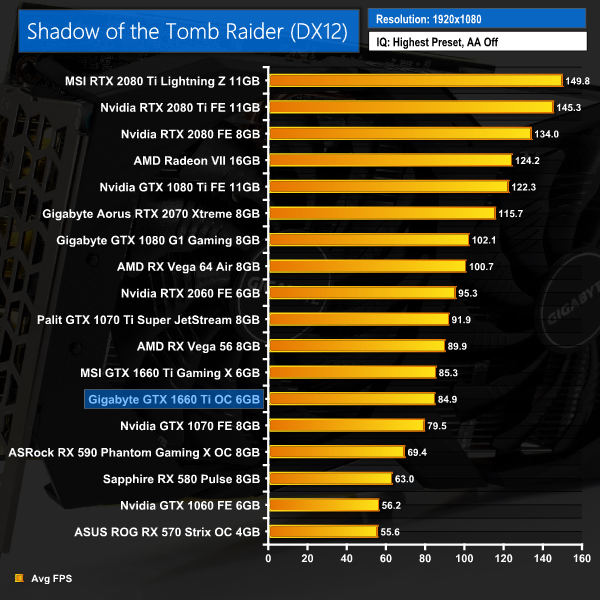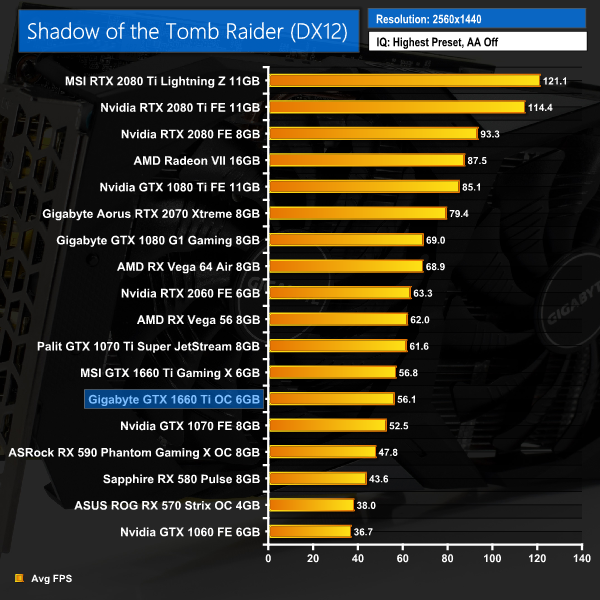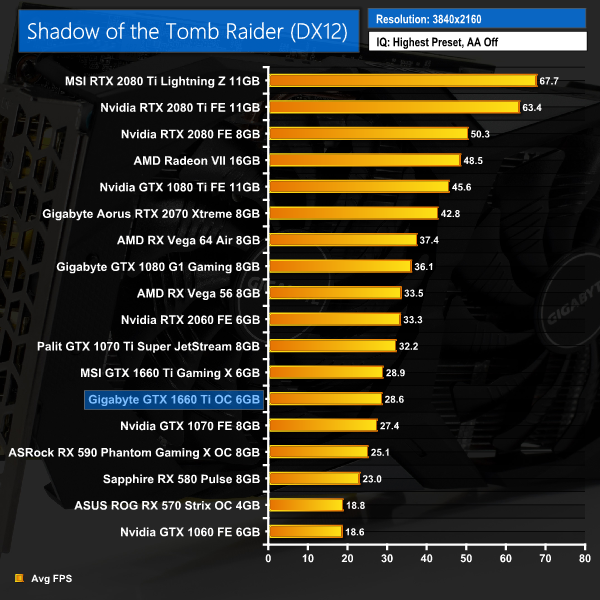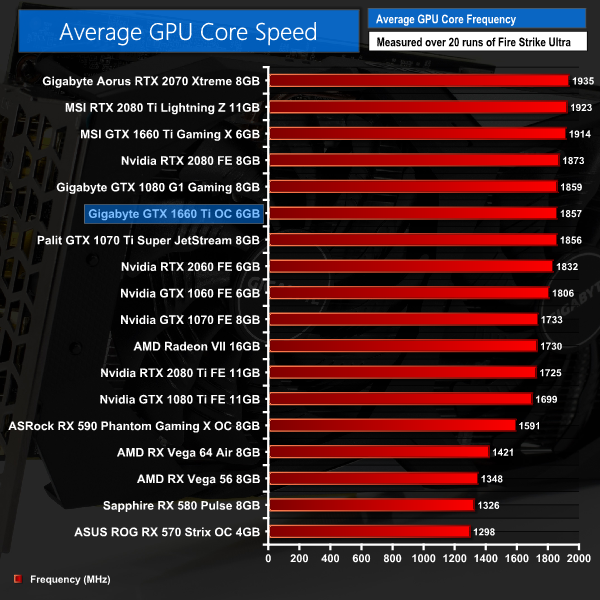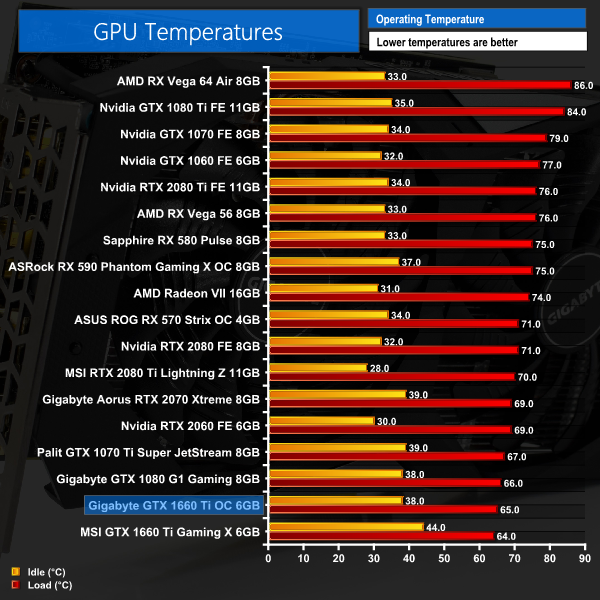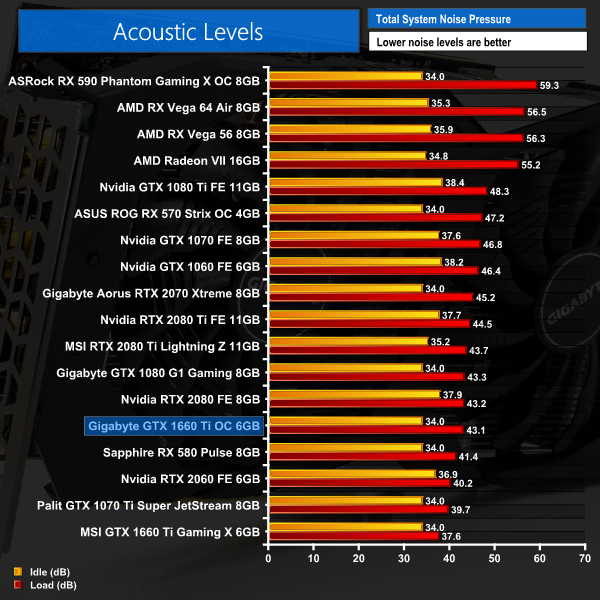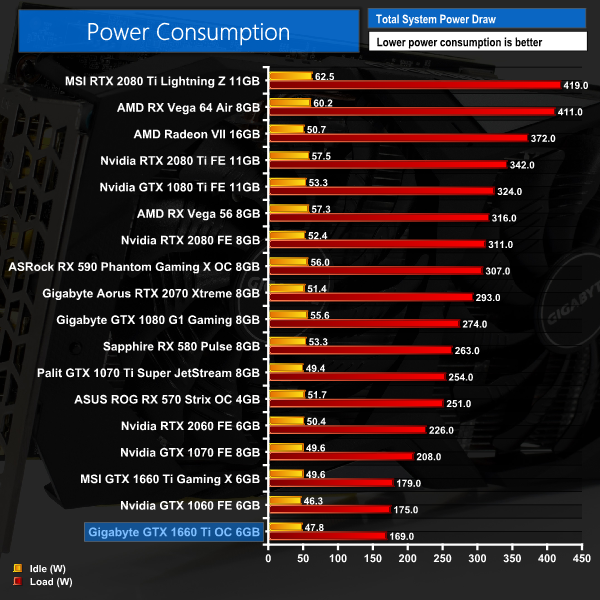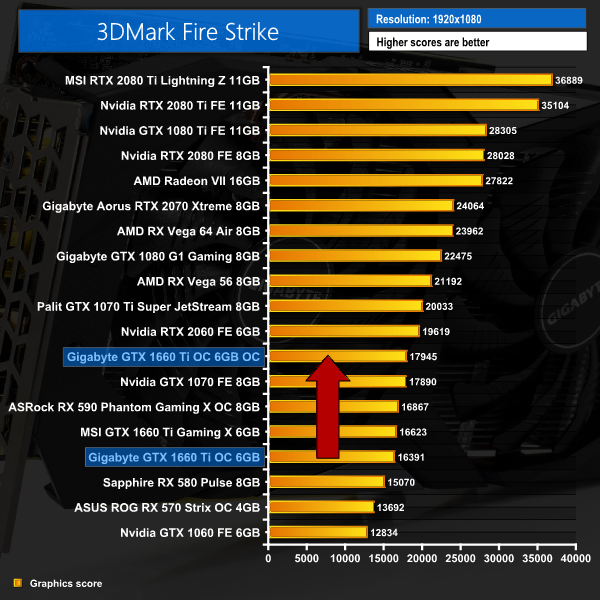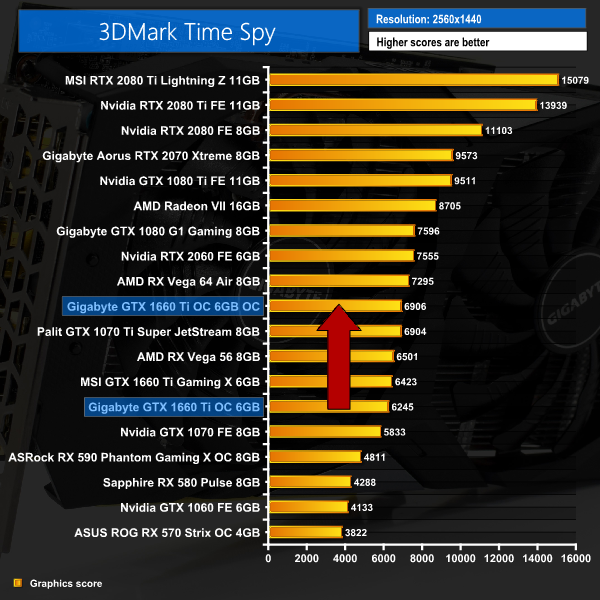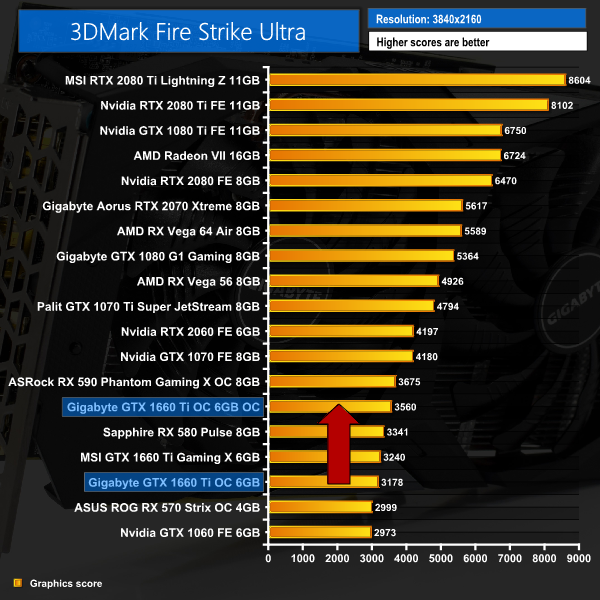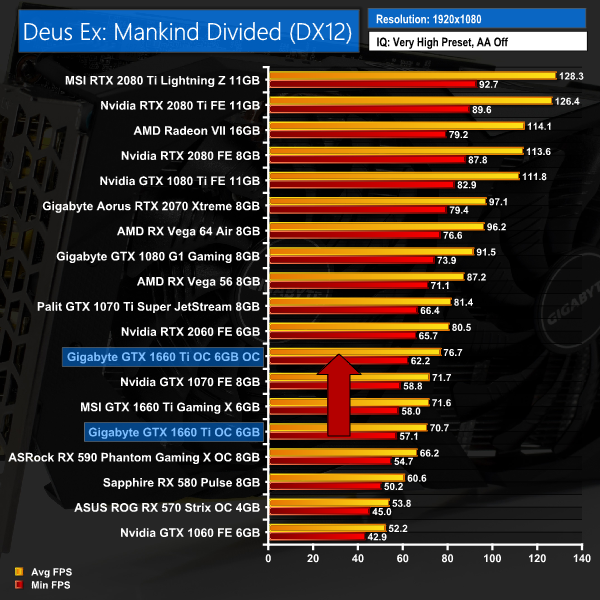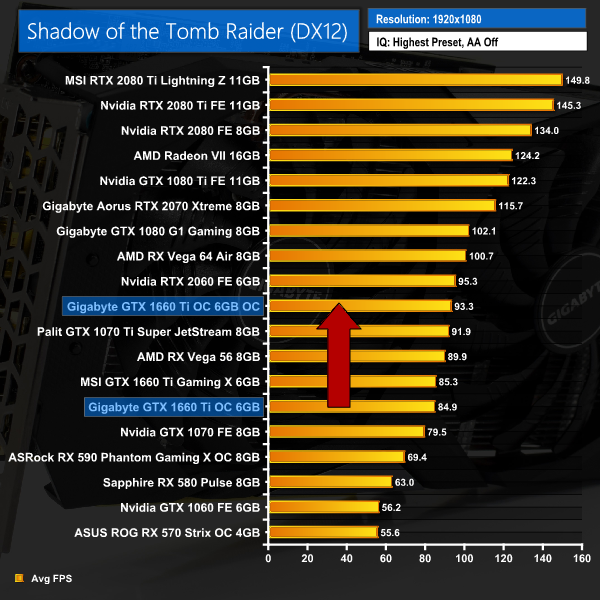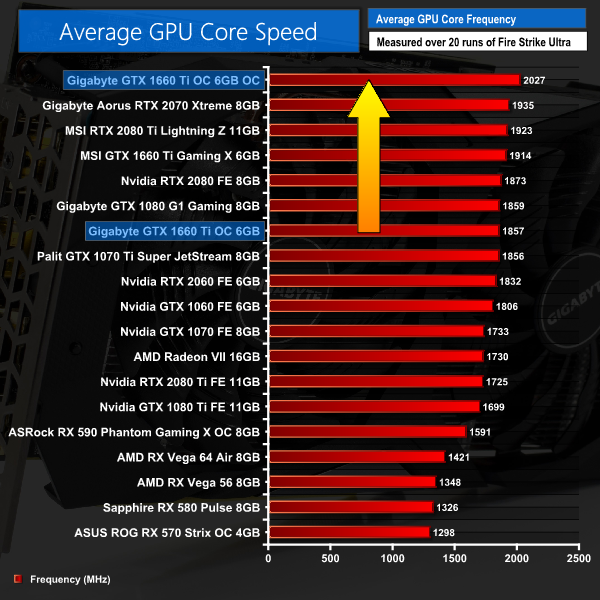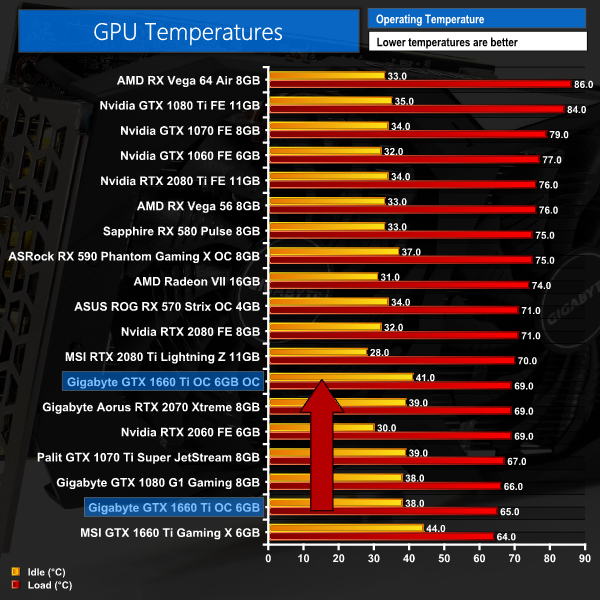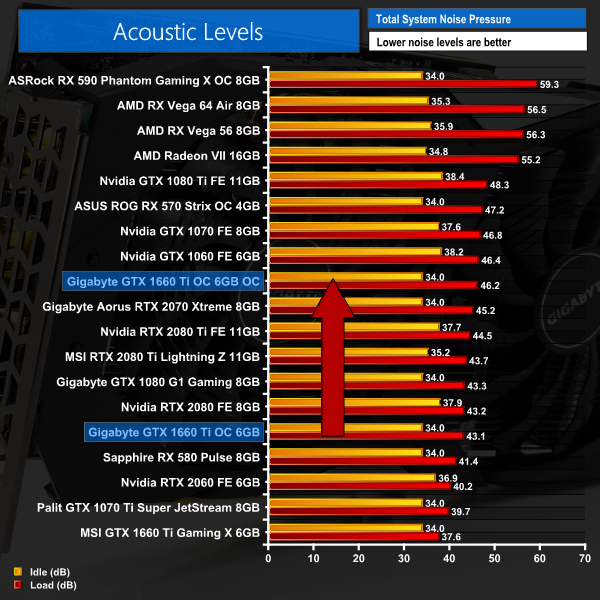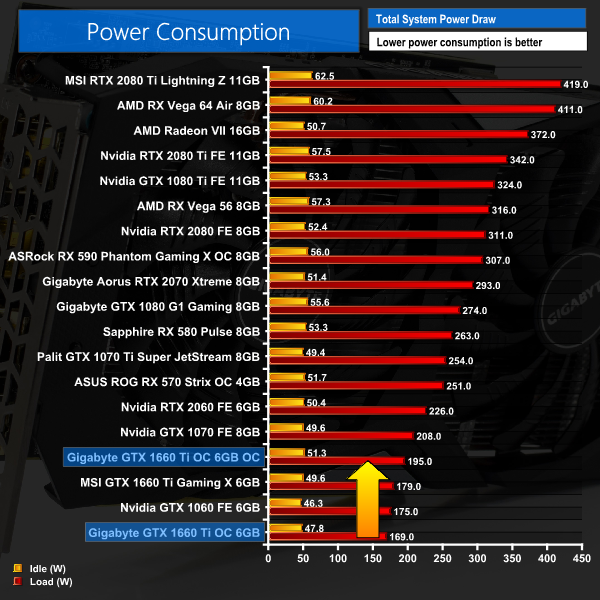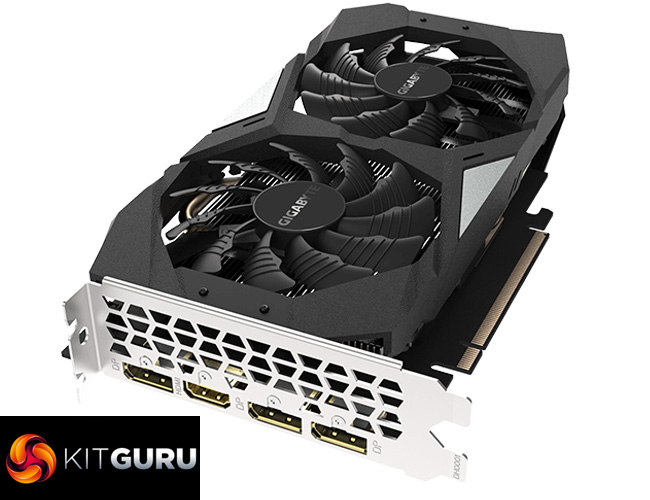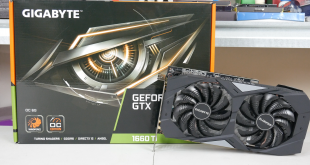
For GTX 1660 Ti launch day, we reviewed the MSI Gaming X card – a high-end factory overclocked model with a £50 price premium over the 1660 Ti's £259 MSRP. While it proved to be a very capable card, the added cost meant it didn't offer very compelling value. That could all change today, however, as we turn to Gigabyte's GTX 1660 Ti OC 6G. It's still a dual-fan, factory overclocked card, but it comes in at just £269, putting it much closer to the baseline MSRP. Is it worth buying?
Taking a look at the various GTX 1660 Tis currently available for £259, a lot of them are actually small, single-fan coolers running at stock speeds. This Gigabyte GTX 1660 Ti OC 6G may be £10 more expensive than the MSRP, but you get a dual-fan ‘Windforce X2' cooler, while the core has also been slightly overclocked – running at 1800MHz instead of 1770MHz.
| GPU | RTX 2070 (FE) | GTX 1070 | RTX 2060 (FE) | GTX 1660 Ti | GTX 1060 |
| SMs | 36 | 15 | 30 | 24 | 10 |
| CUDA Cores | 2304 | 1920 | 1920 | 1536 | 1280 |
| Tensor Cores | 288 | N/A | 240 | N/A | N/A |
| Tensor FLOPS | 63 | N/A | 51.6 | N/A | N/A |
| RT Cores | 36 | N/A | 30 | N/A | N/A |
| Texture Units | 144 | 120 | 120 | 96 | 80 |
| ROPs | 64 | 64 | 48 | 48 | 48 |
| Rays Cast | 6 Giga Rays/sec | 0.65 Giga Rays/sec | 5 Giga Rays/sec | – | 0.44 Giga Rays/sec |
| RTX Performance | 45 Trillion RTX-OPS | 6.5 Trillion RTX-OPS | 37 Trillion RTX-OPS | – | N/A |
| GPU Boost Clock | 1710 MHz | 1683 MHz | 1680 MHz | 1770 MHz | 1708 MHz |
| Memory Data Rate | 14 Gbps | 8 Gbps | 14 Gbps | 12 Gbps | 8 Gbps |
| Total Video Memory | 8GB GDDR6 | 8GB GDDR5 | 6GB GDDR6 | 6GB GDDR6 | 6GB GDRR5 |
| Memory Interface | 256-bit | 256-bit | 192-bit | 192-bit | 192-bit |
| Memory Bandwidth | 448 GB/sec | 256 GB/sec | 336.1 GB/sec | 288.1 GB/sec | 192 GB/sec |
| TDP | 185W | 150W | 160W | 120W | 120W |
The only real difference between this Gigabyte card and the reference spec for GTX 1660 Ti is the clock speed – as mentioned, the OC 6G has been overclocked by 30MHz to give a rated boost clock of 1800MHz. This is 75MHz slower than what MSI achieved with its Gaming X, so it will be interesting to see what kind of performance difference this works out to when we get to our game testing.
Elsewhere, of course all the other core specs of the GTX 1660 Ti are the same. The card uses the TU116 GPU, newly created for GTX 1660 Ti, which is outfitted with 24 SMs and 1536 CUDA cores. There's 6GB GDDR6 memory running at 12Gbps – 2Gbps slower than the GDDR6 we have seen from RTX 20-series cards – but we look at overclocking this later in the review.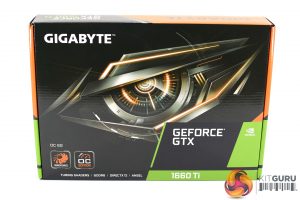

The Gigabyte GTX 1660 Ti OC 6G ships in a dark box, with an image of a large robotic eye taking up most of the front of the box.
Inside, we get little in the way of accessories – there's just a quick start guide and a driver disk.
The card itself looks very similar to other Gigabyte models we have seen recently, with a black plastic shroud and two grey sections. It's pretty plain-looking and nothing that exciting, but at the same time it's also very colour neutral so isn't going to cause issues with a colour coordinated build.
The fans which form the ‘Windforce X2' cooling system measure 90mm in diameter. Interestingly, they both spin in different directions – the left fan spins counter-clockwise, the right fan spins clockwise. Gigabyte says this reduces turbulence and increases airflow pressure, and we will look at thermals later on in the review.
In terms of dimensions, the OC 6G is a very compact card – not as dinky as some of the single-fan 1660 Ti models on the market, but for a dual-fan cooler it is not big at all. Official dimensions are 225.65 x 122.02 x 40.5 mm, meaning it is a standard dual-slot thickness. Under 23cm in length, too, means this should fit in pretty much any case on the market.
On the front side of the card, we can see the plastic shroud wraps round and almost meets the backplate. The Gigabyte logo is printed here in grey text, and it's also worth pointing out there is no RGB lighting on this card at all. That may well appeal to some people, but it may also put off some others.
Personally I am not too bothered either way – a card like this is really all about bang-for-buck, so the RGB is just going to increase the cost, and I think most gamers would rather have an enhanced cooler or factory overclock than RGB at this price point.
As for the backplate, this is actually made of plastic, not metal. That, coupled with the fact it doesn't actually contact the back of the PCB, means it isn't going to provide any cooling for the PCB, but instead it is for aesthetics and also to provide a bit of structural support to the card.
I think it looks pretty good, again it's nothing special, but it is definitely better than looking at an uncovered PCB, while it will also provide some protection from any possible water leakage from a liquid cooler.
In terms of power requirements, the OC 6G sticks to reference spec as it only needs 1x 8-pin PCIe power connector.
Display I/O is also very standard, with 3x DisplayPort and 1x HDMI outputs.
Taking the card apart is very easy – just six screws need to be removed from the back and then we get direct access to the PCB. Gigabyte has opted for a 4-phase solution for the GPU VRM, and 2-phase solution for the GDDR6 memory – the same configuration as MSI's Gaming X card.
The GPU is labelled ‘TU116-400-A1', and remember there is only one TU116 chip – Nvidia is not pre-binning the GPUs into ‘A' and ‘non-A' stacks as it does with the RTX 20-series. The 6GB GDDR6 memory comes from Micron, with the chips labelled ‘DZ177D9WCR'.
As for the cooler and heatsink, this is about as basic as it gets. Gigabyte has used a single fin stack, with just one 6mm copper heatpipe that makes direct contact with the GPU. This pipe runs through a coldplate which cools the VRAM chips, while there is also a smaller coldplate for VRM.
It's clearly not much of a cooler, but then I did mention in my launch-day GTX 1660 Ti review that TU116 does not need much in the way of cooling. Whether or not Gigabyte's solution is enough, however, we will get to later in the review.Our newest GPU test procedure has been built with the intention of benchmarking high-end graphics cards. We test at 1920×1080 (1080p), 2560×1440 (1440p), and 3840×2160 (4K UHD) resolutions.
We try to test using the DX12 API if titles offer support. This gives us an interpretation into the graphics card performance hierarchy in the present time and the near future, when DX12 becomes more prevalent. After all, graphics cards of this expense may stay in a gamer’s system for a number of product generations/years before being upgraded.
We tested the RX Vega64 and Vega56 using the ‘Turbo‘ power mode in AMD’s WattMan software. This prioritises all-out performance over power efficiency, noise output, and lower thermals.
As mentioned, Gigabyte's OC 6G card ups the boost clock from 1770MHz to 1800MHz.
Driver Notes
- All AMD graphics cards (except Radeon VII) were benchmarked with the Adrenalin 19.1.1 driver.
- Radeon VII was benchmarked with a pre-released press driver supplied by AMD.
- All Nvidia graphics cards (except GTX 1660 Ti) were benchmarked with the Nvidia 417.71 driver.
- GTX 1660 Ti was benchmarked with the Nvidia 418.91 driver supplied to press.
Test System
We test using the Overclockers UK Germanium pre-built system, though it has been re-housed into an open-air test bench. You can read more about it over HERE.
| CPU |
Intel Core i7-8700K
Overclocked to 4.8GHz |
| Motherboard |
ASUS ROG Strix Z370-F Gaming
|
| Memory |
Team Group Dark Hawk RGB
16GB (2x8GB) @ 3200MHz 16-18-18-38 |
| Graphics Card |
Varies
|
| System Drive |
Patriot Wildfire 240GB
|
| Games Drive | Crucial M4 512GB |
| Chassis | Streacom ST-BC1 Bench |
| CPU Cooler |
OCUK TechLabs 240mm AIO
|
| Power Supply |
SuperFlower Leadex II 850W 80Plus Gold
|
| Operating System |
Windows 10 Professional
|
Comparison Graphics Cards List
- MSI RTX 2080 Ti Lightning Z 11GB
- Nvidia RTX 2080 Ti Founders Edition (FE) 11GB
- Nvidia RTX 2080 Founders Edition (FE) 8GB
- Gigabyte Aorus RTX 2070 Xtreme 8GB
- Nvidia RTX 2060 Founders Edition (FE) 6GB
- MSI GTX 1660 Ti Gaming X 6GB
- Nvidia GTX 1080 Ti Founders Edition (FE) 11GB
- Gigabyte GTX 1080 G1 Gaming 8GB
- Palit GTX 1070 Ti Super JetStream 8GB
- Nvidia GTX 1070 Founders Edition (FE) 8GB
- Nvidia GTX 1060 Founders Edition (FE) 6GB
- AMD Radeon VII 16GB
- AMD RX Vega 64 Air 8GB
- AMD RX Vega 56 8GB
- ASRock RX 590 Phantom Gaming X OC 8GB
- Sapphire RX 580 Pulse 8GB
- ASUS RX 570 ROG Strix Gaming OC 4GB
Software and Games List
- 3DMark Fire Strike & Fire Strike Ultra (DX11 Synthetic)
- 3DMark Time Spy (DX12 Synthetic)
- Battlefield V (DX12)
- Deus Ex: Mankind Divided (DX12)
- Far Cry 5 (DX11)
- Tom Clancy’s Ghost Recon: Wildlands (DX11)
- Middle Earth: Shadow of War (DX11)
- Shadow of the Tomb Raider (DX12)
We run each benchmark/game three times, and present averages in our graphs.3DMark Fire Strike is a showcase DirectX 11 benchmark designed for today’s high-performance gaming PCs. It is our [FutureMark’s] most ambitious and technical benchmark ever, featuring real-time graphics rendered with detail and complexity far beyond what is found in other benchmarks and games today.
Unsurprisingly, our initial testing shows the Gigabyte OC 6G sitting just below the MSI Gaming X GTX 1660 Ti. Considering the MSI card is clocked 75MHz faster, the small but just about noticeable performance gap is to be expected.Battlefield V is a first-person shooter video game developed by EA DICE and published by Electronic Arts. Battlefield V is the sixteenth instalment in the Battlefield series. It was released worldwide for Microsoft Windows, PlayStation 4, and Xbox One on November 20, 2018. (Wikipedia).
We test using the Ultra preset with the DX12 API. We usually include ray tracing results with BFV, but we have excluded those here as DXR is not a feature applicable to the GTX 1660 Ti.
Gigabyte's GTX 1660 Ti comes in very close to the MSI Gaming X in Battlefield V. Across all resolutions, the performance difference is never more than 1FPS on average.Deus Ex: Mankind Divided is set in the year 2029, two years after the events of Human Revolution and the “Aug Incident”—an event in which mechanically augmented humans became uncontrollable and lethally violent. Unbeknownst to the public, the affected augmented received implanted technology designed to control them by the shadowy Illuminati, which is abused by a rogue member of the group to discredit augmentations completely. (Wikipedia).
We test using the Very High preset, with MSAA disabled. We use the DirectX 12 API.
Deus Ex: Mankind Divided again has both GTX 1660 Ti models within touching distance of each other. The gap between 1660 Ti and RTX 2060 is only about 10FPS when gaming at 1080p, too.Far Cry 5 is an action-adventure first-person shooter game developed by Ubisoft Montreal and Ubisoft Toronto and published by Ubisoft for Microsoft Windows, PlayStation 4 and Xbox One. It is the eleventh entry and the fifth main title in the Far Cry series, and was released on March 27, 2018.
The game takes place in the fictional Hope County, Montana, where charismatic preacher Joseph Seed and his cult Project at Eden’s Gate holds a dictatorial rule over the area. The story follows an unnamed junior deputy sheriff, who becomes trapped in Hope County and works alongside factions of a resistance to liberate the county from Eden’s Gate. (Wikipedia).
We test using the Ultra preset, with AA and motion blur disabled.
Gigabyte's GTX 1660 Ti outperforms the GTX 1070 Founders Edition at both 1080p and 1440p in Far Cry 5. The MSI Gaming X is less than 2FPS faster across the board.Tom Clancy’s Ghost Recon Wildlands is a tactical shooter video game developed by Ubisoft Paris and published by Ubisoft. It was released worldwide on March 7, 2017, for Microsoft Windows, PlayStation 4 and Xbox One, as the tenth installment in the Tom Clancy’s Ghost Recon franchise and is the first game in the Ghost Recon series to feature an open world environment. (Wikipedia).
We test using the Very High preset.
Ghost Recon: Wildlands is known to favour Nvidia hardware over AMD cards, and that explains why this 1660 Ti performs almost exactly the same as Vega 56 at 1080p resolution. Even at 1440p, the OC 6G averages almost 60FPS here.Middle-earth: Shadow of War is an action role-playing video game developed by Monolith Productions and published by Warner Bros. Interactive Entertainment. It is the sequel to 2014’s Middle-earth: Shadow of Mordor, and was released worldwide for Microsoft Windows, PlayStation 4, and Xbox One on October 10, 2017. (Wikipedia).
We test using the Very High preset.
Middle Earth: Shadow of War is one of the few titles where GTX 1070 is consistently faster than this Gigabyte 1660 Ti, with a performance gap of just over 5FPS at 1080p. That shrinks to just 1.2FPS at 1440p, however.Shadow of the Tomb Raider is an action-adventure video game developed by Eidos Montréal in conjunction with Crystal Dynamics and published by Square Enix. It continues the narrative from the 2013 game Tomb Raider and its sequel Rise of the Tomb Raider, and is the twelfth mainline entry in the Tomb Raider series. The game released worldwide on 14 September 2018 for Microsoft Windows, PlayStation 4 and Xbox One. (Wikipedia).
We test using the Highest preset, with AA disabled. We test using the DX12 API.
Shadow of the Tomb Raider shows the GTX 1660 Ti establishing a healthy performance advantage over GTX 1070, with another 5FPS gap at 1080p, while this drops to 3.6FPS at 1440p. The difference between both GTX 1660 Ti models is never more than 1FPS across all three resolutions tested.Here we present the average clock speed for each graphics card while running the 3DMark Fire Strike Ultra stress test 20 times. We use GPU-Z to record the GPU core frequency during the Fire Strike Ultra runs. We calculate the average core frequency during the entire 20-run test to present here.
With a rated boost clock of 1800MHz, our testing shows the Gigabyte OC 6G ran almost 60MHz faster than this, with an average frequency of 1857MHz. This is 57MHz slower than the MSI Gaming X 1660 Ti, and as our game testing showed, this works out to a real-world performance difference of 1-2FPS.For our temperature testing, we measure the peak GPU core temperature under load, as well as the GPU temperature with the card idling on the desktop. A reading under load comes from running the 3DMark Fire Strike Ultra stress test 20 times. An idle reading comes after leaving the system on the Windows desktop for 30 minutes.
At the beginning of this review, I commented on the very basic cooler that Gigabyte has used for this card – it isn't big and uses a single copper heatpipe. Clearly, TU116 doesn't need more than that as this card still ran very cool, with a peak GPU temperature of 65C. Compared to the MSI Gaming X, this is only 1C warmer, although as we will see on the next page, the Gigabyte card is a bit louder.
The results from our thermal gun were initially very surprising for me – both hot spots were under 50C which is exceptional. However, when I took the card apart I realised why this was the case. In a nutshell, the plastic shroud on the front of the card, as well as the backplate, don't actually contact with the PCB or the heatsink of the card.
That means there isn't nearly as much thermal transfer between the GPU and the shroud/backplate – the latter is for aesthetics and structural support, not heat dissipation. So while these results might initially look fantastic, they aren't comparable to most other cards we have tested for the reason outlined above.We take our noise measurements with the sound meter positioned 1 foot from the graphics card. I measured the sound floor to be 34 dBA, thus anything above this level can be attributed to the graphics cards. The power supply is passive for the entire power output range we tested all graphics cards in, while all CPU and system fans were disabled.
A reading under load comes from running the 3DMark Fire Strike Ultra stress test 20 times. An idle reading comes after leaving the system on the Windows desktop for 30 minutes.
I mentioned on the previous page that it was good to see the Gigabyte 1660 Ti running just 1C hotter than the MSI Gaming X, despite the basic cooler. That holds true, but clearly Gigabyte has had to run its two fans a bit faster to achieve those temperatures, as noise levels peaked in the 43dB region.
To be clear, this isn't really that loud – it is audible certainly, and definitely a fair bit louder than the near silent-running Gaming X – but compared to a lot of other cards, it is relatively quiet.We measure system-wide power draw from the wall while the card is sat idling at the Windows 10 desktop for 30 minutes. A reading under load comes from running the 3DMark Fire Strike Ultra stress test 20 times.
Interestingly, this Gigabyte 1660 Ti draws 10W less than the higher-clocked MSI Gaming X model, meaning it is actually less power hungry than GTX 1060 – despite the massive performance increase. I said as much in my review of the Gaming X, but Nvidia is clearly streets ahead of AMD in the power efficiency race.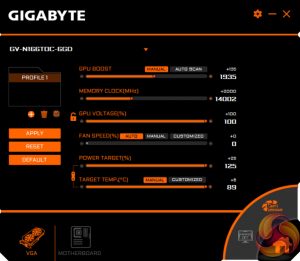
For overclocking, we used Gigabyte's Aorus Master utility. We managed an extra +135MHz to the GPU core and +1000MHz (2000MHz effective) to the memory.
3DMark and games testing
This overclock brought impressive performance gains for the Gigabyte card. Not only did our Fire Strike score increase by 9.5%, but we also gained an extra 8FPS playing Shadow of the Tomb Raider.
Average clock speed under load
This is thanks to our real-world clock speed increasing from 1857MHz all the way to 2027MHz – an increase of 170MHz. We only managed to get MSI's Gaming X up to 2003MHz, which goes to show you don't necessarily need one of the top-end cards to achieve the best overclocks – though of course this very much card-dependent.Here, we take a further look at the impact of our overclock, looking at the increased temperatures, acoustics and power draw.
Temperatures
Acoustics
Power consumption
Overview
As a whole, the card didn't suffer too badly from this overclock. GPU temperatures increased by 4C – from 65C to 69C, which is still a decent result. The worst part of running the overclock was the increased noise, with the emissions reaching 46dB. Power draw also increased by some 25W, though this is still less than GTX 1070.Following on from our launch day review of the £310 MSI GTX 1660 Ti Gaming X 6G, today we have assessed the Gigabyte GTX 1660 Ti OC 6G. While it is still £10 more expensive than Nvidia's MSRP for the 1660 Ti, at £269 this card is definitely a much more appealing value proposition than the premium MSI card.
You can tell the OC 6G has been built to a price. The plastic shroud is quite plain to look at, even the backplate is made of plastic. The cooler is also very basic, with just a single copper heatpipe, and there is no lighting of any kind on this card.
That being said, this card delivers where it counts, and that is in the performance department. Despite a 75MHz clock speed deficit compared to MSI's Gaming X, in actual games this Gigabyte is never more than 1.2FPS slower at 1080p. In fact, average performance is just 1.4% better with the MSI. So from a purely bang for buck perspective, the Gigabyte OC 6G makes a lot more sense.
The cooler actually performs reasonably well, too. I had my doubts when I took it apart, but my sample peaked at just 65C under load which is a great result. Noise levels is the one area where MSI does have a decent advantage, as this Gigabyte card produced around 43dB of noise – almost 6dB more than the MSI Gaming X. Clearly, Gigabyte's twin fans are having to work harder to keep temperatures low, but even then it is still not really a loud card.
It also overclocked very well, with our frequency improving by 170MHz – from 1857MHz to 2027MHz. That means it actually overclocked further than the MSI Gaming X, despite that card's beefier cooling solution and higher price. A lot of this does come down to the ‘silicon lottery', but prospective GTX 1660 Ti buyers who are happy to overclock could well save money with a cheaper card like this, especially as Nvidia is not binning the TU116 GPUs into two stacks.
So on the whole, I have to say it is pretty easy to come to a conclusion about the Gigabyte GTX 1660 Ti OC 6G. It's not the most sophisticated card we've ever come across, and noise levels are a touch higher than I'd like. But for £269, it just offers excellent value by performing effectively the same as the more expensive MSI Gaming X card we reviewed for launch day.
There is still the matter of Vega 56, and it appears that Sapphire's Pulse card can now be found for £289.99. Vega 56 performs about 10% faster, on average, than a GTX 1660 Ti so anyone looking for slightly increased raw performance may well be tempted by that. The downside, however, is power consumption, with Vega 56 pulling almost twice as much power as a 1660 Ti.
For its 1660 Ti though, Gigabyte has done a good job of producing a fast-running and cool card for just £10 above MSRP, so this OC 6G comes well recommended if you are in the market for a compact and power efficient 1080p/1440p gaming graphics card.
You can buy the OC 6G from Overclockers UK for £269.99 HERE.
Pros
- Just £10 above MSRP.
- Barely any performance difference between this and the higher-end MSI Gaming X.
- Runs cool.
- Low power draw.
- Very compact.
Cons
- Vega 56, at its current price of £289, is a compelling alternative if the higher power draw is not a problem for you.
- Slightly louder than I'd like.
KitGuru says: GTX 1660 Ti is most appealing when cards are priced as close to MSRP as possible. Gigabyte has done a good job of producing this card for £269, with no major drawbacks to worry about.
 KitGuru KitGuru.net – Tech News | Hardware News | Hardware Reviews | IOS | Mobile | Gaming | Graphics Cards
KitGuru KitGuru.net – Tech News | Hardware News | Hardware Reviews | IOS | Mobile | Gaming | Graphics Cards


